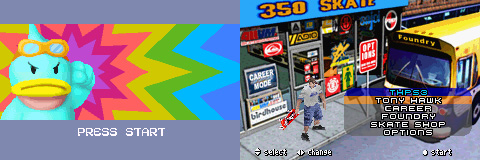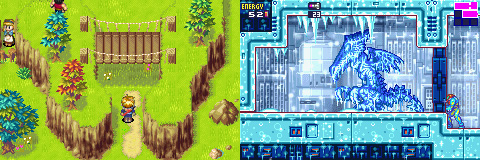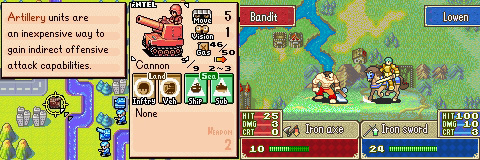Game Boy Memories Part #4
May 9th, 2009

More to Come
The upright, grey brick may have already received its inauguration into the 20-Somethings, but it’s life is hardly over, at least for me anyways! While I’m rather up to date with the compulsory, must-play portable titles, there are a few holes that I’m still hoping to plug as well as a handful of titles that I’m simply curious to explore. Maybe you can lend a hand?
Peering over my laptop screen I can see Wario Land III, Metroid II, Kirby Tilt and Tumble (might give Kirby a miss) and Legend of the River King that all need proper play throughs. I unfortunately missed out on most of those titles the first time around. Actually Kirby T&T is imported, never came out in PAL regions, maybe I ought to give it a shot, I’m weary of having to wiggle around the GBC though, will likely hinder vision.
On the GBA I’d like to replay the two Pokemon titles as well as the excellent Kuru Kuru Kurrin which is more difficult than I remember it. On top of these three are Mario Kart Super Circuit (turned this down originally, gasp!), Castlevania Double-Pak and Fire Emblem: Sacred Stones, the last two which I’ve kinda started. Wow, certainly some heavy hitters to look forward too.

This post isn’t intended to brag about titles already within my possession though. I hate materialism, and don’t wish to whine over unfortunate dilemmas like which games I intend on playing next. Seriously, people complained about this issue last Christmas, if they don’t like having so much to play, maybe they can sell their unused games to clog up retail chains. I want to instead spew out a list of names that interest me, maybe if you’ve had some experience yourself, you can pitch in with ideas/suggestions.
As one of the few people to pimp ambitious portable developer Vicarious Visions, I’m interested to go hands on with one of the seven (is it really seven?!) isometric iterations of the Tony Hawk franchise. I remember the fuss surrounding THPS2 at the GBA launch, the hype leveling it with PSone quality graphics. That’s obviously a lie, but the titles are still a technical milestone.
Metal Gear Solid on the GBC is a game that I also ought to add to my collection. This game has received unanimous critical acclaim, and before GTA IV and the Orange Box ever showed up, MGS GBC was firmly holding a position in GameRankings top 5 best titles. I hear there’s an Aboriginal villain in it too!
My brother and I are avid fans of the Harvest Moon franchise, yet we’d dare touch anything but the sacred SNES original. Even though the quality of the newer titles tends fluctuate a little, the series appears to have evolved respectably, still that doesn’t shake hardened fans like us. I’m curious though, with the exception of the off-shoot Rune Factory series, how do some of the games stack up? The GBC titles seem interesting place to ponder that question.

Lastly, I am dying to play (probably through emulation, I suspect) Stranded Kids or Survival Kids, I’m not sure which is the PAL/NTSC name here. This GBC game is the precursor to the Lost in Blue series. I’ve been intrigued by this RPG since I first caught eye of it in NMS magazine, yet I’ve never seen it on store shelves. The premise seems to place the game in the same obscure, life-RPG niche as Harvest Moon and Legend of the River King.
And that concludes this week’s Game Boy retrospective. I wish this was done and dusted last we, but sometimes time doesn’t permit. I hope you’ve enjoyed reading it as much as I’ve enjoyed writing it. For now we return to the regular broadcasting content.
All images used in this series proudly swiped from MobyGames
Game Boy Memories Part #3
May 7th, 2009

Game Boy Advance
It’s getting harder to discuss the Game Boy the further I move along the line of iterations. The quality of games per each platform is increasing, and generally speaking so has my enjoyment with each, yet the nostalgia factor is shrinking too.
My brother had earned enough money through cash-in-hand jobs that he was able to buy a himself a Game Boy Advance within a year of its release. Fortunately for me, I was able to crib off his hard work for a couple of years until the Game Boy Advance SP was released. I originally wanted so desperately to own one of the limited edition, ultra-slick Rip Curl GBA SP units (pictured in the header). Typically I lucked out and most copies were snapped up quickly while I tried to scrounge together another $20 to make up the price tag.
Golden Sun was the first title my twin bought, recommended positive press on the magazine scene. I remember the first time I played it, sitting in my room, in the same spot I am now, with headphones on, juggling the unit to gleam enough of the sun’s rays. The music was incredible, it had a real airy atmosphere to it. I remember pausing for 20 minutes at the end of the first dungeon to sample the musical score. The graphics too had a pseudo-3D look to it thanks to shaded sprites (giving each body part a circular appearance), shadows and other tricks the game employed to create a sense of depth. The battles were dynamic, fast and engaging, a technical powerhouse of ideas and a clear leap above the SNES. Golden Sun was an early look at the future potential of the GBA. It’s a pity there weren’t more titles to peak Golden Sun‘s aptitude to sharp presentation and design – very contemporary for its time.

I sometimes feel trapped in a sad world where Advance Wars fans outnumber Fire Emblem fans. We’re all marching to spanky tunes, sharp transitions and a youthful air. The charisma is undeniable upbeat, perhaps too much so for a game that tackles the topic matter of war. I love Advance Wars for all it offered; mainly busting S ranks off the easy maps in the War Room while failing to worm my way through the main story. Advance Wars had this unshakable layer of intellect to it, the same variation of intellect that makes one a good player of chess – I usually stuck to draughts. There’s just a mentation that I always buggered up when strategizing my units, a way of thinking that is still out of my mind’s reach that make me at odds with this series.
Fire Emblem picked up those pieces, and welcomed me to the opposite end of the SRPG genre from much beloved Final Fantasy Tactics (PSone). This is strategy that speaks to me, well contextualized (steeped in hierarchic Medieval tongue) and better animated. The battle animations still leave me awe inspired, the fluidity of the sprite work encouraged me to to make my own animated gifs from sprite dumps of the game. I’m sure if I were to one day conduct a proper analysis of Fire Emblem it would reveal some embarrassing similarities with the Advance Wars framework. Enough so that I’d realize my fear of Advance Wars is all just in my head. Either way, this title strengthened my love for all things SRPG and instantly turned me into an conscious consumer of Intelligent Systems’ games. Seriously, this developer has breathed much variation into the Nintendo fold.

Metroid Fusion and Metroid Zero Mission are another pair of unforgettable GBA classics – seem to be operating it twos today. Purists may balk at the linearity of Metroid Fusion, but the title brought some interesting elements to the franchise, most notable of which being SA-X, the evil Samus. Her presence was unnerving, marked with cold foot steps through the abandoned halls. Haters of Fusion say that Zero Mission is a better game, and they’re probably right. Fusion had a stylish, light-blue elegance to it, the environments felt lived in, a naturally conjoining network of catacombs overrun by vegetation and abandonment – it was a modern Metroid. Zero Mission feels bulky and recycled (as it is) in comparison; cliched and dated. Although some areas of the used map are fleshed out, the core framework is centred around 3-4 core divisions as in the original (this is a remake by the way). The game places you in limbo, balancing sending you back an forth to several divisions of the map. The game only truly comes into its own when Samus attempts to leave Zebes and crash lands back on the planet near the Space Pirate Mothership. Her abilities and power suit are striped and we get to play in an extended episode, where she stealthily infiltrates the alien compound. Playing as the tight skinned “Zero Suit Samus”, the game becomes conscious of the fandom in ways Nintendo normally don’t permit. Nice call.
And then we arrive at Final Fantasy Tactics Advance; the most atrocious abomination ever to be accepted by the video gaming community. No, no, no, that’s enough! I refuse to attach myself to this sin. Post over.
Game Boy Memories Part #2
May 5th, 2009

Game Boy Color Era
Compared to the original, black-and-white Game Boy, the Game Boy Color had a rather short life-span of about 3 years. As a sharp blow to my love of the portable, I never actually owned a GBC, despite the large number of titles that caught my attention. I don’t believe that I could afford it at the time. As I said in my previous musings on the system, the GBC in it’s short life span arguably had a line up better than the past decade of Game Boy titles, which made missing out all the more painful. I did make up for my absence due to the backwards compatible titles, and later playing catch up on the GBA.
The most standout title of the GBC years would undoubtedly be the Zelda: Oracle of Seasons/Ages duo. Originally planned as a trilogy (completing the Din, Nayru, Farore arrangement), Seasons and Ages linked together two games, similar in structure, varying in mechanics. I played this title alongside my brother and a friend so that the three of us could unlock the whole experience. Ages was the more seasoned game, tougher puzzles being a key contributor but both games provided similarly high quality experiences. Capcom took the reigns of these title and did solid justice of the Zelda series, delivering a title to appease more hardened fans of the series.

During the GBC years I use to salvage titles that allowed B&W play, one of these titles was Pokemon Trading Card Game. Sure, it’s a Pokemon spin-off, but it was a bloody good card game too. My brother and I first rented this title (we didn’t rent games that often, mind you) and finished the title as a pair, only to buy the title a few weeks later and finish it individually. I personally detest trading card games, they’re stupid, money-spinning time-wasters, yet TCG I liked, really liked. Even though the game is built around a deck of cards, I never mentally put the two together, which probably explains why I enjoyed it so much. There was no fat to it, go to gym, battle moochers until you reach the gym leader, beat him, go to next gym – it was all about the card battles. I also remember the music being really intense, particularly in important battles, when the bass is rolling and cards are being shuffled, you know this game means business.
Polished in almost every way, the Mario sports series (Mario Tennis and Mario Golf) are both excellent examples of wholesome gaming experiences. Both titles thoughtfully translate these sports into digital equivalents, layer it with content and combine the package in an RPG shell. Golf uses a two-touch bar system where one first lines up a moving power bar, to then again line up the retraction for accuracy. It’s a simple system that works to great effect. The polish is what makes it shine though, smart course designs, a range of clubs and additional spin mechanics vary the experience. Tennis is more or less basic tennis, with effects added to the ball dependent on which buttons pressed. There’s a slight strategy involved in managing the three types of shots, four if you include volleys. The RPG contexts flesh out a storyline and give the game a sense of progression, and something to do outside of the sport itself. They’re a hub to access the gracious amounts of additional training courses and challenges. The Game Boy Advance versions are also well worth a look, even if they are remakes/highly derivative.

Pokemon Gold/Silver still maintained my interest, although by that stage I found myself enjoying the adventure less, it lacked the sense of familiarity that the previous games had. I often found myself unsure on how to progress and which Pokemon I ought to adopt into my party. The series had become too ahead of itself. The Donkey Kong Country port to the GBC was impressive, although hardly worth playing over SNES original, the mini-games and additional content were slick but felt too attached to DK 64 which we won’t discuss. In the past year I also picked up Perfect Dark and enjoyed that quite a bit. It’s a string of interesting set pieces, the standard action was a little clumsy due to the low resolution tightening the amount of visual lead way, but overall it was a very solid, sophisticated little brother to the N64 game.



 Game Design Companion: A Critical Analysis of Wario Land 4 - $7.99
Game Design Companion: A Critical Analysis of Wario Land 4 - $7.99 Level Design: Processes and Experiences
Level Design: Processes and Experiences Speed Boost: The Hidden Secrets Behind Arcade Racing Design - $5.99
Speed Boost: The Hidden Secrets Behind Arcade Racing Design - $5.99 Adventures in Games Analysis: Volume I - $5.99
Adventures in Games Analysis: Volume I - $5.99







